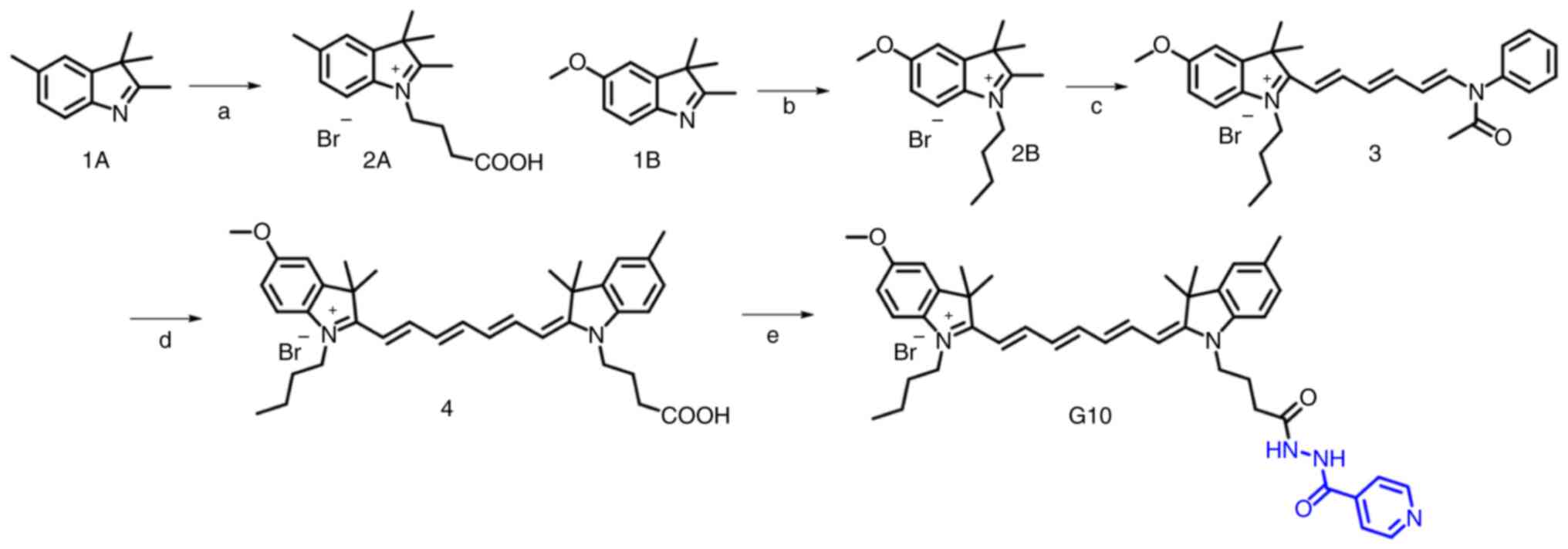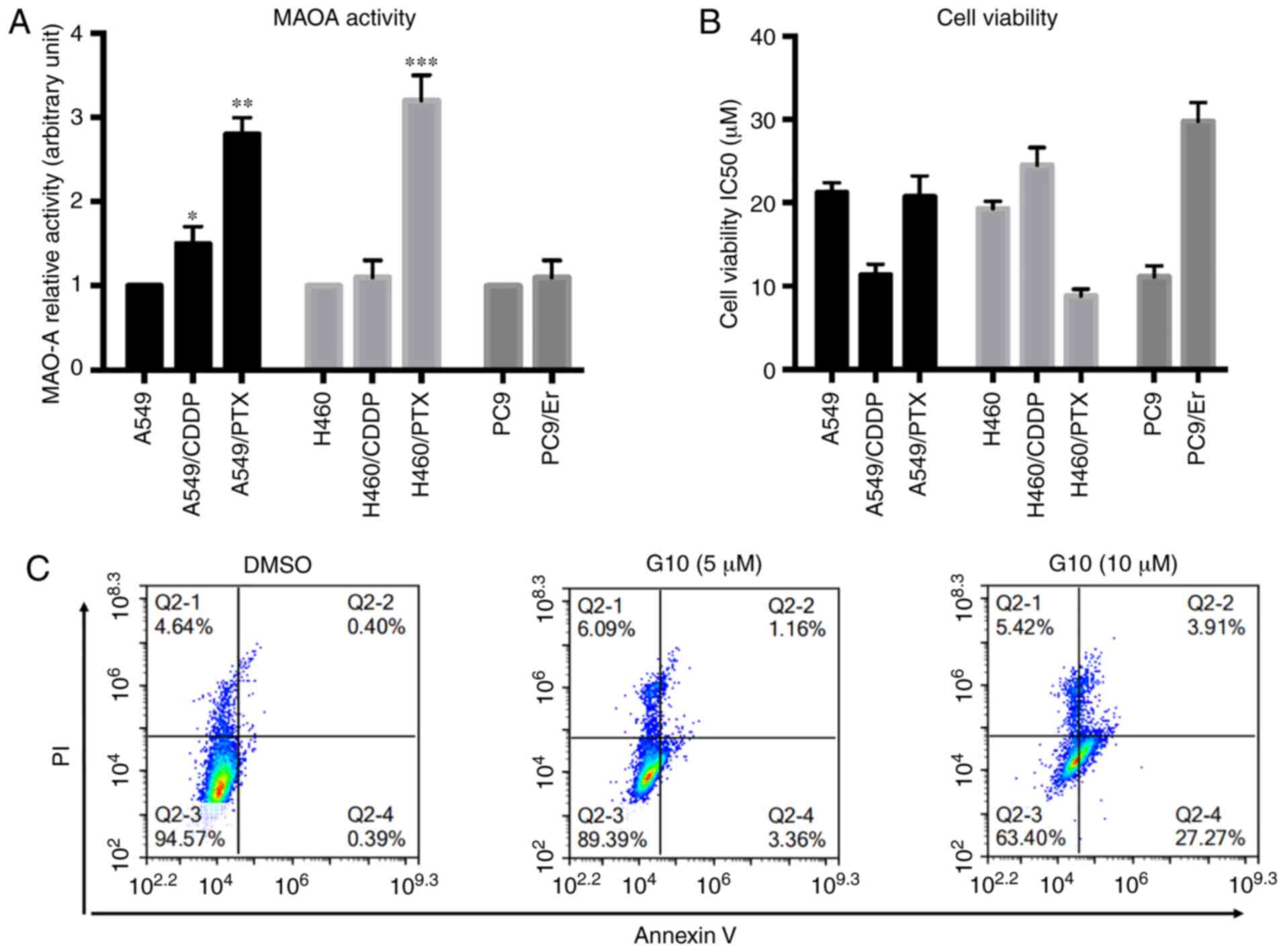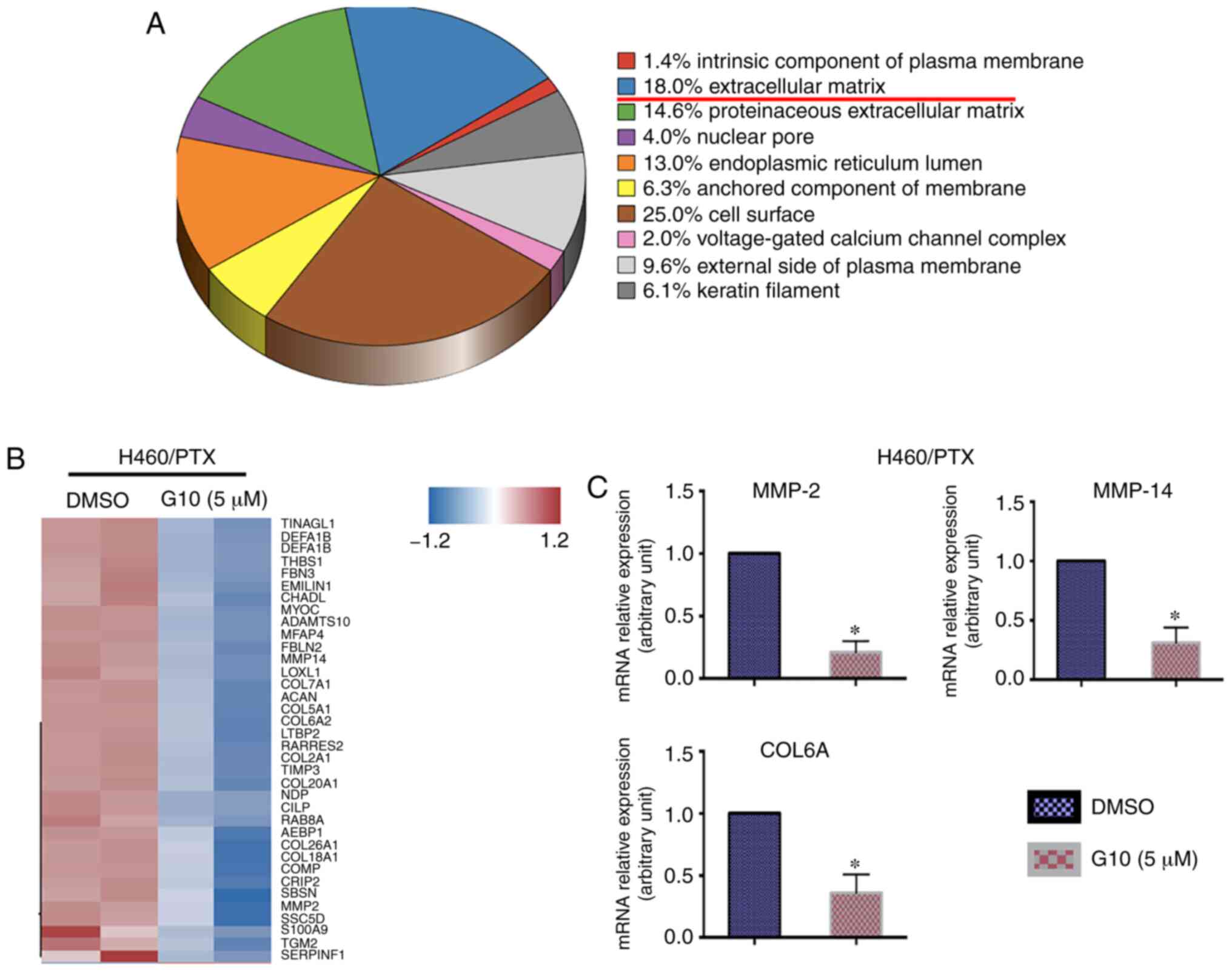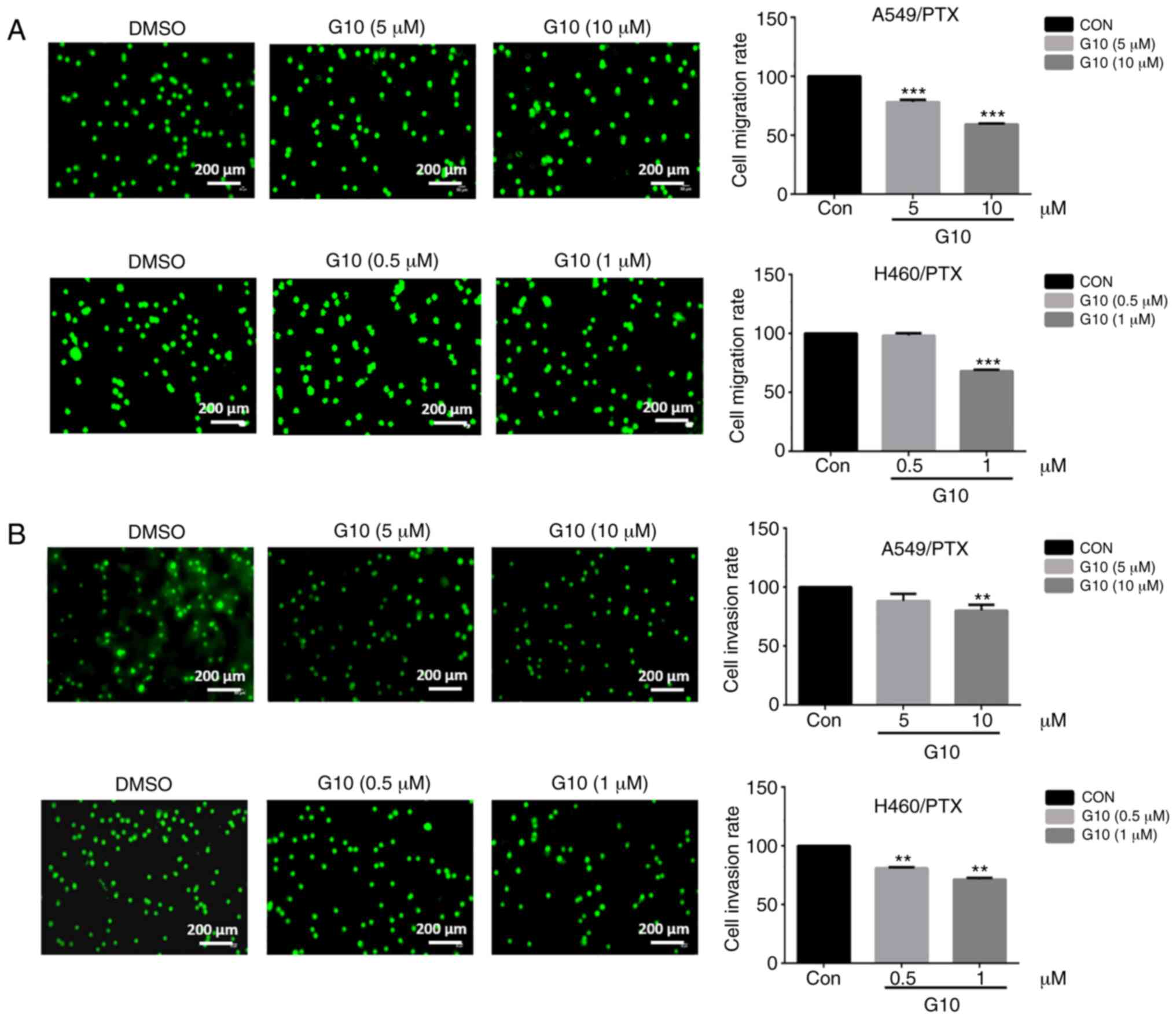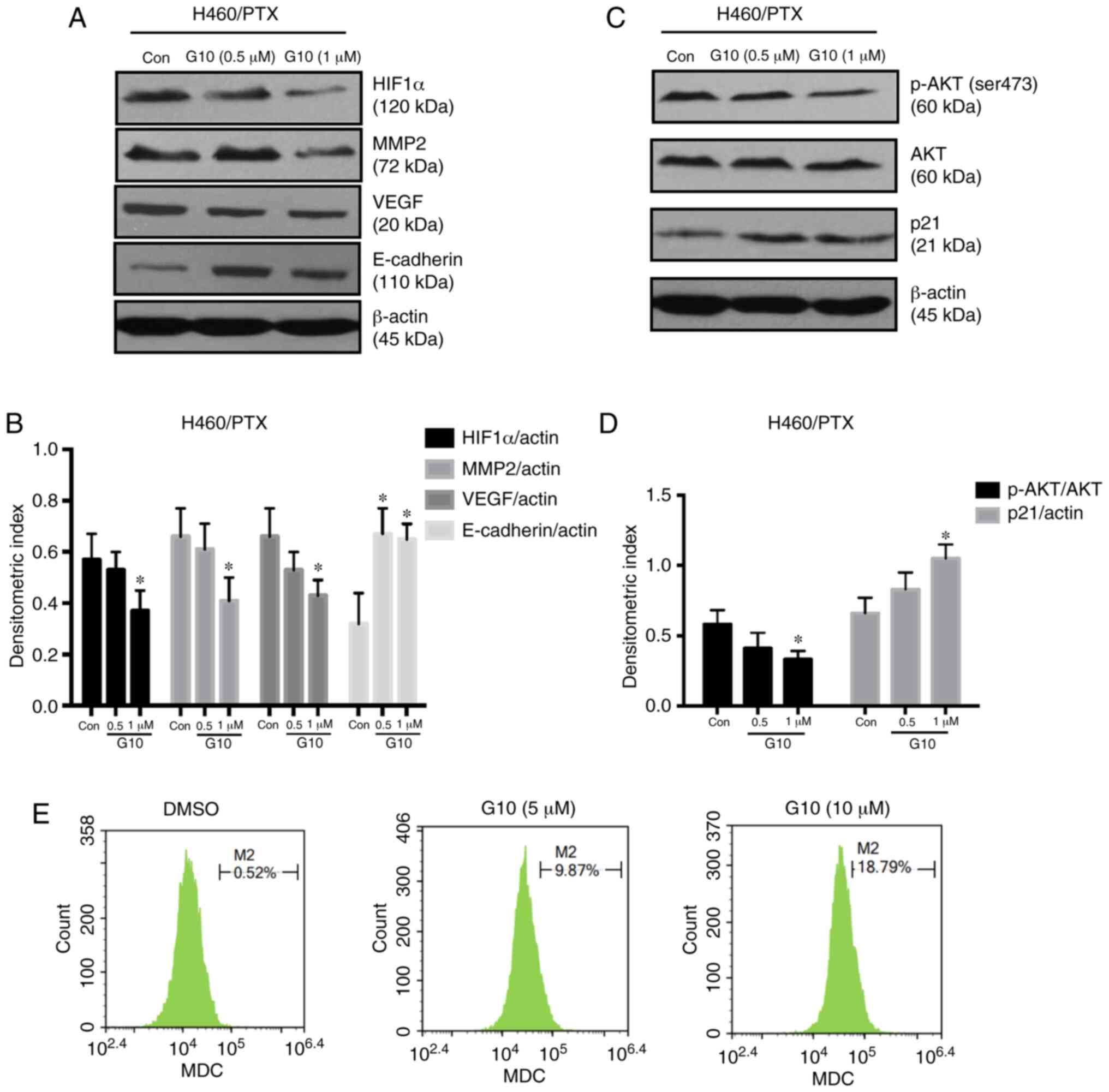|
1
|
Herbst RS, Morgensztern D and Boshoff C:
The biology and management of non-small cell lung cancer. Nature.
553:446–454. 2018. View Article : Google Scholar : PubMed/NCBI
|
|
2
|
Chen Z, Fillmore CM, Hammerman PS, Kim CF
and Wong KK: Non-small-cell lung cancers: A heterogeneous set of
diseases. Nat Rev Cancer. 14:535–546. 2014. View Article : Google Scholar : PubMed/NCBI
|
|
3
|
Zhang C, Leighl NB, Wu YL and Zhong WZ:
Emerging therapies for non-small cell lung cancer. J Hematol Oncol.
12:452019. View Article : Google Scholar : PubMed/NCBI
|
|
4
|
Terlizzi M, Colarusso C, Pinto A and
Sorrentino R: Drug resistance in non-small cell lung cancer
(NSCLC): Impact of genetic and non-genetic alterations on
therapeutic regimen and responsiveness. Pharmacol Ther.
202:140–148. 2019. View Article : Google Scholar : PubMed/NCBI
|
|
5
|
Shih JC, Chen K and Ridd MJ: Monoamine
oxidase: From genes to behavior. Annu Rev Neurosci. 22:197–217.
1999. View Article : Google Scholar : PubMed/NCBI
|
|
6
|
Brunner HG, Nelen M, Breakefield XO,
Ropers HH and Van Oost BA: Abnormal behavior associated with a
point mutation in the structural gene for monoamine oxidase A.
Science. 262:578–580. 1993. View Article : Google Scholar : PubMed/NCBI
|
|
7
|
Schwartz TL: A neuroscientific update on
monoamine oxidase and its inhibitor. CNS Spectr. 18 (Suppl
1):S25–S33. 2013. View Article : Google Scholar
|
|
8
|
Lin YC, Chang YT, Campbell M, Lin TP, Pan
CC, Lee HC, Shih JC and Chang PC: MAOA-a novel decision maker of
apoptosis and autophagy in hormone refractory neuroendocrine
prostate cancer cells. Sci Rep. 7:463382017. View Article : Google Scholar : PubMed/NCBI
|
|
9
|
Wu JB, Shao C, Li X, Li Q, Hu P, Shi C, Li
Y, Chen YT, Yin F, Liao CP, et al: Monoamine oxidase A mediates
prostate tumorigenesis and cancer metastasis. J Clin Invest.
124:2891–2908. 2014. View
Article : Google Scholar : PubMed/NCBI
|
|
10
|
Li PC, Siddiqi IN, Mottok A, Loo EY, Wu
CH, Cozen W, Steidl C and Shih JC: Monoamine oxidase A is highly
expressed in classical Hodgkin lymphoma. J Pathol. 243:220–229.
2017. View Article : Google Scholar : PubMed/NCBI
|
|
11
|
Shih JC: Monoamine oxidase isoenzymes:
Genes, functions and targets for behavior and cancer therapy. J
Neural Transm (Vienna). 125:1553–1566. 2018. View Article : Google Scholar : PubMed/NCBI
|
|
12
|
Kushal S, Wang W, Vaikari VP, Kota R, Chen
K, Yeh TS, Jhaveri N, Groshen SL, Olenyuk BZ, Chen TC, et al:
Monoamine oxidase A (MAO A) inhibitors decrease glioma progression.
Oncotarget. 7:13842–13853. 2016. View Article : Google Scholar : PubMed/NCBI
|
|
13
|
Wu JB, Lin TP, Gallagher JD, Kushal S,
Chung LW, Zhau HE, Olenyuk BZ and Shih JC: Monoamine oxidase A
inhibitor-near-infrared dye conjugate reduces prostate tumor
growth. J Am Chem Soc. 137:2366–2374. 2015. View Article : Google Scholar : PubMed/NCBI
|
|
14
|
Liu F, Hu L, Ma Y, Huang B, Xiu Z, Zhang
P, Zhou K and Tang X: Increased expression of monoamine oxidase A
is associated with epithelial to mesenchymal transition and
clinicopathological features in non-small cell lung cancer. Oncol
Lett. 15:3245–3251. 2018.PubMed/NCBI
|
|
15
|
Yang X, Shao C, Wang R, Chu CY, Hu P,
Master V, Osunkoya AO, Kim HL, Zhai HE and Chung LWK: Optical
imaging of kidney cancer with novel near infrared heptamethine
carbocyanine fluorescent dyes. J Urol. 189:702–710. 2013.
View Article : Google Scholar : PubMed/NCBI
|
|
16
|
Yang X, Shi C, Tong R, Qian W, Zhau HE,
Wang R, Zhu G, Cheng J, Yang VW, Cheng T, et al: Near IR
heptamethine cyanine dye-mediated cancer imaging. Clin Cancer Res.
16:2833–2844. 2010. View Article : Google Scholar : PubMed/NCBI
|
|
17
|
Yi X, Yan F, Wang F, Qin W, Wu G, Yang X,
Shao C, Chung LW and Yuan J: IR-780 dye for near-infrared
fluorescence imaging in prostate cancer. Med Sci Monit. 21:511–517.
2015. View Article : Google Scholar : PubMed/NCBI
|
|
18
|
Wang Y, Liu T, Zhang E, Luo S, Tan X and
Shi C: Preferential accumulation of the near infrared heptamethine
dye IR-780 in the mitochondria of drug-resistant lung cancer cells.
Biomaterials. 35:4116–4124. 2014. View Article : Google Scholar : PubMed/NCBI
|
|
19
|
Huang H, Long S, Li M, Gao F, Du J, Fan J
and Peng X: Bromo-pentamethine as mitochondria-targeted
photosensitizers for cancer cell apoptosis with high efficiency.
Dyes Pigments. 149:633–638. 2018. View Article : Google Scholar
|
|
20
|
Shi C, Wu JB and Pan D: Review on
near-infrared heptamethine cyanine dyes as theranostic agents for
tumor imaging, targeting, and photodynamic therapy. J Biomed Opt.
21:509012016. View Article : Google Scholar : PubMed/NCBI
|
|
21
|
Zhang E, Luo S, Tan X and Shi C:
Mechanistic study of IR-780 dye as a potential tumor targeting and
drug delivery agent. Biomaterials. 35:771–778. 2014. View Article : Google Scholar : PubMed/NCBI
|
|
22
|
Usama SM, Lin CM and Burgess K: On the
mechanisms of uptake of tumor-seeking cyanine dyes. Bioconjug Chem.
29:3886–3895. 2018. View Article : Google Scholar : PubMed/NCBI
|
|
23
|
Yang XG, Mou YH, Wang YJ, Wang J, Li YY,
Kong RH, Ding M, Wang D and Guo C: Design, synthesis, and
evaluation of monoamine oxidase A inhibitors-indocyanine dyes
conjugates as targeted antitumor agents. Molecules. 24:14002019.
View Article : Google Scholar
|
|
24
|
Wu JB, Chen K, Li Y, Lau YF and Shih JC:
Regulation of monoamine oxidase A by the SRY gene on the Y
chromosome. FASEB J. 23:4029–4038. 2009. View Article : Google Scholar : PubMed/NCBI
|
|
25
|
Wang L, Chen G, Lu X, Wang S, Han S, Li Y,
Ping G, Jiang X, Li H, Yang J and Wu C: Novel chalcone derivatives
as hypoxia-inducible factor (HIF)-1 inhibitor: Synthesis,
anti-invasive and anti-angiogenic properties. Eur J Med Chem.
89:88–97. 2015. View Article : Google Scholar : PubMed/NCBI
|
|
26
|
Wang LH, Jiang XR, Yang JY, Bao XF, Chen
JL, Liu X, Chen GL and Wu CF: SYP-5, a novel HIF-1 inhibitor,
suppresses tumor cells invasion and angiogenesis. Eur J Pharmacol.
791:560–568. 2016. View Article : Google Scholar : PubMed/NCBI
|
|
27
|
Valastyan S and Weinberg RA: Tumor
metastasis: Molecular insights and evolving paradigms. Cell.
147:275–292. 2011. View Article : Google Scholar : PubMed/NCBI
|
|
28
|
Kai F, Drain AP and Weaver VM: The
extracellular matrix modulates the metastatic journey. Dev Cell.
49:332–346. 2019. View Article : Google Scholar : PubMed/NCBI
|
|
29
|
Brown Y, Hua S and Tanwar PS:
Extracellular matrix-mediated regulation of cancer stem cells and
chemoresistance. Int J Biochem Cell Biol. 109:90–104. 2019.
View Article : Google Scholar : PubMed/NCBI
|
|
30
|
Eble JA and Niland S: The extracellular
matrix in tumor progression and metastasis. Clin Exp Metastasis.
36:171–198. 2019. View Article : Google Scholar : PubMed/NCBI
|
|
31
|
Kleiner DE and Stetler-Stevenson WG:
Matrix metalloproteinases and metastasis. Cancer Chemother
Pharmacol. 43 (Suppl):S42–S51. 1999. View Article : Google Scholar : PubMed/NCBI
|
|
32
|
Chiu KH, Chang YH, Wu YS, Lee SH and Liao
PC: Quantitative secretome analysis reveals that COL6A1 is a
metastasis-associated protein using stacking gel-aided purification
combined with iTRAQ labeling. J Proteome Res. 10:1110–1125. 2011.
View Article : Google Scholar : PubMed/NCBI
|
|
33
|
Hou T, Tong C, Kazobinka G, Zhang W, Huang
X, Huang Y and Zhang Y: Expression of COL6A1 predicts prognosis in
cervical cancer patients. Am J Transl Res. 8:2838–2844.
2016.PubMed/NCBI
|
|
34
|
Theocharis AD, Skandalis SS, Gialeli C and
Karamanos NK: Extracellular matrix structure. Adv Drug Deliv Rev.
97:4–27. 2016. View Article : Google Scholar : PubMed/NCBI
|
|
35
|
Semenza GL: Hypoxia-inducible factors:
Mediators of cancer progression and targets for cancer therapy.
Trends Pharmacol Sci. 33:207–214. 2012. View Article : Google Scholar : PubMed/NCBI
|
|
36
|
Gonzalez-Avila G, Sommer B, Mendoza-Posada
DA, Ramos C, Garcia-Hernandez AA and Falfan-Valencia R: Matrix
metalloproteinases participation in the metastatic process and
their diagnostic and therapeutic applications in cancer. Crit Rev
Oncol Hematol. 137:57–83. 2019. View Article : Google Scholar : PubMed/NCBI
|
|
37
|
Hafner C, Landthaler M and Vogt T:
Activation of the PI3K/AKT signalling pathway in non-melanoma skin
cancer is not mediated by oncogenic PIK3CA and AKT1 hotspot
mutations. Exp Dermatol. 19:e222–e227. 2010. View Article : Google Scholar : PubMed/NCBI
|
|
38
|
Nödling AR, Mills EM, Li X, Cardella D,
Sayers EJ, Wu SH, Jones AT, Luk LYP and Tsai YH: Cyanine dye
mediated mitochondrial targeting enhances the anti-cancer activity
of small-molecule cargoes. Chem Commun (Camb). 56:4672–4675. 2020.
View Article : Google Scholar : PubMed/NCBI
|
|
39
|
Choi PJ, Park TIH, Cooper E, Dragunow M,
Denny WA and Jose J: Heptamethine cyanine dye mediated drug
delivery: Hype or hope. Bioconjug Chem. 31:1724–1739. 2020.
View Article : Google Scholar : PubMed/NCBI
|















